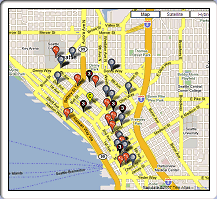This is the second page of the whitepaper Optical Fiber and 10 Gigabit Ethernet.
Part1: here
MultiMode Fiber
Multimode fiber is used extensively in the campus LAN environment where distances between buildings are 2 km or less. The broad market penetration and acceptance of 62.5/125 micron multimode fiber was initiated by its inclusion in the Fiber Distributed Data Interface (FDDI) standard. FDDI, developed under ANSI in the late 1980s, drove the use of 62.5 micron multimode fiber into the campus LAN environment. The “FDDI grade” multimode fiber specification is currently referenced in many networking standards (such as Ethernet, Token Ring, and ATM) and in the TIA/EIA 568-A cabling standard.
During the development of the FDDI standard, a number of commercially available multimode and single-mode fiber types were considered to meet the FDDI objective of achieving a 100 Mbps data rate (125 Mbaud) over distances of up to 2 km on fiber cable. Multimode was favored over single-mode because it met the 2 km distance objective and had the advantage of lower cost transceivers. At that time, the commercially available multimode fiber types were 50/125, 62.5/125, 85/125, and 100/140 micron. 50/125 micron fiber continues to be popular in Japan and Europe and is supported in the ISO/IEC 11801 standard (Generic cabling for customer premises). The 85/125 micron fibers were based on international initiatives and its use as a LAN fiber alternative. The 100/140 micron product is specified in a number of networking applications and used in military applications.
| Core/Cladding | Application |
|---|---|
| 50/125 micron | First long haul telecommunications fiber deployed with lasers. Today, it is being used in campus LAN premises applications such as 10GbE; specified in ISO/IEC 11801 and TIA/EIA-568 cabling standards. |
| 62.5/125 micron | Due to larger core diameter and higher numerical aperture it couples more light from LED sources than 50/125 fiber. Driven into the market by LED-based systems such as FDDI. |
| 85/125 micron | Requirements for this fiber were based on international initiatives and its use as LAN fiber. Sensitive to bending-induced optical losses. Least used multimode fiber. |
| 100/140 micron | Used in low data rate, short distance applications. More light coupling into the larger core makes it less sensitive to fiber and connector loss. |
Fiber information carrying capacity is typically rated in terms of a bandwidth length product (MHz-km), which can be used to determine how far a system can operate at what bit rate (e.g., 1 Gbps or 10 Gbps). Naturally, as transmission speed goes up, for a given modal bandwidth, the distance that the signal can travel is reduced.
At transmission speeds up to 622 Mbps (OC-12/STM-4) multimode fiber can be driven with a light emitting diode (LED). However, beyond those speeds an LED can’t turn on and off fast enough and therefore a laser source is required. During the development of the 1 Gigabit Ethernet standard, it was discovered that multimode fiber bandwidth using a laser launch could be lower than the bandwidth when measured with a light emitting diode (LED) launch. To mitigate this affect and achieve acceptable multimode fiber optic operating distances for 1 GbE and 10GbE, specifications had to be created to address the fiber optic transmitter launch conditions, the fiber optic receiver bandwidth, and the fiber cable characteristics.
This is page 2 of 4. Continue to next page
Links of interest:
- Ethernet Whitepapers
- USA Business & Carrier Metro Ethernet
- Metro Wave Division Multiplexing, DWDM Services and DWDM/ROADM
- Business Phone Systems (external)
- International WAN & DIA Services
- Wholesale SIP Termination (carrier & enterprise)
If you found this page helpful, please support us linking to this page.
- 62 5/125 micron fiber 10 gb
- multi mode fiber 10 GBps
- hp 100/140 micron fiber optic
- hp 10 gigabit multimode standards
- how to find bandwidth length product for fibers formula
- how to find 50/125 or 62 5/125
- fiber optic bandwidth gigabit\
- ethernet vs fddi
- ethernet 100 micron fiber
- can multimode 1 gigabit fiber be used for 10
Related posts:

